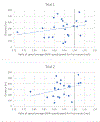Evaluating Test-Retest Reliability of Fatigability in Chronic Stroke
- PMID: 34242857
- PMCID: PMC8767492
- DOI: 10.1016/j.jstrokecerebrovasdis.2021.105895
Evaluating Test-Retest Reliability of Fatigability in Chronic Stroke
Abstract
Objectives: The subjective nature of fatigue may contribute to inconsistencies in prevalence rates for post-stroke fatigue. More objective performance fatigue measures may offer a more reliable construct of fatigue. Our goal was to establish test-retest reliability of fatigability in stroke during 6-minute walk (6MW) testing. Relationships between post-stoke fatigability and other constructs were assessed.
Materials and methods: Twenty-three hemiparetic stroke survivors underwent two 6MW tests with portable metabolic monitoring performed at least 48 hours apart. Fatigability was defined as ratio of change in walking speed to distance covered during the 6MW. 6MW oxygen consumption (VO2), peak aerobic capacity (VO2peak), walking speed over-ground, dynamic gait index, fatigue, falls efficacy, and BMI were measured.
Results: Fatigability was highly correlated between both 6MW trials (ICC = 0.99, p < 0.001) with no significant difference between trials (0.08, p = 0.48). The strongest correlation was between fatigability and 6MW VO2 trial 1 and 2 (r = 0.92, p < 0.001 and r = 0.95, p < 0.001, respectively). Moderate-to-strong relationships were observed between fatigability for 6MW and fastest-comfortable walking speed (r = -0.82 and -0.77), self-selected walking speed (r = -7.8 and -0.78), 6MW walking speed (r = -0.80 and 0.80, VO2peak (r = -0.47 and -0.48) (p < 0.001), and DGI (r = -0.70 and -0.68, p < 0.001).
Conclusion: This study establishes test-retest reliability for an objective measure of fatigue in stroke-related disability. The strong correlations between fatigability and other functional measures also provides insight into the contributors underlying fatigability in this population.
Registration: URL: http://www.clinicaltrials.gov. Unique identifier: NCT01322607.
Keywords: Function; Rehabilitation; Stroke; Task performance and analysis.
Copyright © 2021. Published by Elsevier Inc.
Conflict of interest statement
Declaration of Competing Interest There are no conflicts of interest to report.
Figures



References
-
- van der Werf SP, van den Broek HL, Anten HW, Bleijenberg G. Experience of sever fatigue long after stroke and its relation to depression symptoms and disease characteristics. Eur Neurol 2001;45:28–33. - PubMed
-
- Ingles JL, Eskes GA, Phillips SJ. Fatigue after stroke. Arch Phys Med Rehabil 1990;90:173–178. - PubMed
-
- Vestergaard S, Nayfield SG, Patel KV, Eldadah BE, Cesari M, Ferrucci L, Ceresnini G, Guralnik JM. Fatigue in a representative population of older persons and its association with functional impairment, functional limitations, and disability. J Gerontol A Biol Sci Med Sci 2009. Jan;64(1):76–82. - PMC - PubMed
-
- Aylund K, Era P, Davidsen M, Gause-Nilsson I. Items bias in self-reported functional ability among 75-year-old men and women in three nordiac localities. Scand J Soc Med 1996;24(3):206–217. - PubMed
-
- Moreh E, Jacobs JM, Stessman J. Fatigue, function, and mortability in older adults. J Gerontolo A Biol Sci Med Sci 2010;65(8):887–895. - PubMed
MeSH terms
Associated data
Grants and funding
LinkOut - more resources
Full Text Sources
Medical

